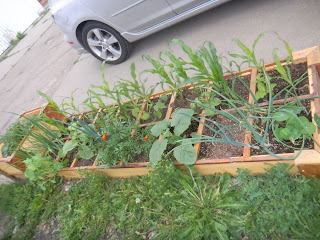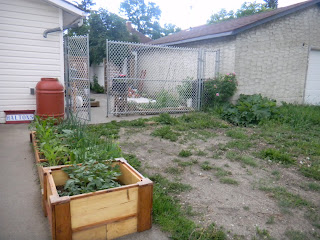I post this here because acts of Urban Homesteading are impacting, and will continue to impact, communities and neighbourhoods in the city. It's an important wrestle for anyone homesteading in areas where revitalization is occurring.
The font screamed from the lamppost, its capital letters in heavy black Sharpie: “GENTRIFICATION IS THE NEW COLONIALISM”.
I liked how this simple, succinct statement of withering contempt made me think. I liked the challenge of it. I marveled at how the use of five words can so swiftly turn a dialogue into a big, bloody battle.
Gentrification is a word that digs back into English history and refers to the gentry or ‘landed people’. It is used today to describe the middle class’s return to the centre of the city to live. It is usually used with a negative connotation.
“What’s so wrong with people who have money, power and education?” You ask.
Besides what’s wrong with most people- occasional bad humour, indigestion, and secret families- the fear is less about them as people and more on their impact on the most vulnerable residents in a neighbourhood. The fear is that the middle class move in and- well- there goes the community. Literally. No one else, but other middle and upper class people can afford to buy or rent the houses that have ‘desirable neighbourhood’ price tags attached.
Of course, gentrification doesn’t happen over night in a neighbourhood with significant crime and social upheaval. Gentrification happens in spurts over time. The amount of time it takes and number of times properties change hands is different in each city and region. And it’s hard to say when gentrification is complete. Is it when everyone has the same income? When everyone has the same values? When bylaws are introduced to forbid clotheslines?
As long as there is free market and free movement of people, the city’s neighbourhood demographics will change. In the 50s, our neighbourhood began to see significant movement of people away from the centre. The suburbs were being built in earnest and they were more attractive, affordable and accessible than ever before. My grandfather grew up in Alberta Avenue (his father owned an appliance store on 95 Street), and in 1948 was part of a new church plant. All of the twelve families that started the church lived in the neighbourhood however by 1970 only one member of the congregation still called Norwood home. This was a significant time of transition for many in the community. People moved for all sorts of reasons, and in their place investors purchased homes that often quickly deteriorated. Locally owned businesses closed or moved to more prime locations, leaving gaping holes in the landscapes of 111 and 118 Ave. Churches closed or reinvented themselves as commuter churches. Many of the new residents were the working poor or newcomers to Canada and were often caught in cycles of poverty- preyed upon by slum landlords or greasy drug dealers. By 1970, the increased presence of the sex trade in the community further stressed market values and community optimism.
This was the story across North America’s city cores. However, for some time now, the trend is changing. With the onset of ideals of the New Urbanism, the city is no longer viewed through the lenses of rat infested, polluted Industrial Revolution cities (Charles Dickens impacted our neighbourhoods more than we give him credit!). City living has become desirable for its own aesthetic and quality of life. And there are other advantages: shorter commute means more time with family and friends, better access to city cultural events and public transportation.
Here in Alberta Avenue, the gentrification trend was clearly also fuelled by a red-hot real estate market through the early 2000s into 2008. In 2007, the inner city areas in Edmonton were the only areas you could find a single detached home for under $250,000. As the market climbed, many people began to worry that they would never be able to get into the market and so they bought whatever they could. And it often meant living in an area that for years had been maligned by parents or feared by classmates.
My husband and I have lived here since 2004 when we bought our first home for what my family thought was an exorbitant price considering the address ($130,000). We moved here to be close to our work and so that we could live alongside neighbours with diversity of background, culture and class. I love the cheap espresso at the bakeries. I love the easygoing atmosphere of the library. I love our boulevard trees. And depending on the renovation schedule, I either love or hate my home.
In all of my coming and goings, I am keenly aware of my role in revitalization and my fear of contributing to gentrification. I’m not sure where our family fits (and there aren’t any gentrification centres that determine its parameters), but we earn a middle class salary, own a vehicle, and have university degrees so I think I may be a threat. Will planting flowers in my back alley just make the neighbourhood prettier, hence more attractive for a prospective home buyer who turns the rooming house across the alley into a single family dwelling which in turn displaces six people? Perhaps I shouldn’t plant flowers, or paint my fence, or walk my dog, or have a coffee on the porch or… I might just negatively impact the city.
It’s like ‘gentrification’ is some wild, giant boogeyman that might snatch my children or feed on my liver… Or worse still, it will feed on really poor children’s livers.
TV dramas thrive on this stuff:
Scene #1- Young woman runs wildly from the dark alley. She screams: “They’re coming, in a huge Mercedes with house plans the size of a meteor.”
Scene #2- Senior man in a wheel chair wearing a ratty cardigan weeps at his kitchen table while his super rich landlady drums her manicured nails on the counter and barks, “You’ve got until tomorrow to find another place. I’ll take the keys now.” The camera zooms in on the five year old’s iphone as she watches Hannah Montana.
Satire aside, I don’t want to undermine the injustice that displacement of already vulnerable people can cause. I’ve worked with families facing few options in life and it is a painful place to be. In my opinion, however, the primary challenge in looking at revitalization through the lens of gentrification is that we begin to read situations and meet people from a primarily classist perspective. Surely being aware of one’s privilege is critical in being a more empathetic individual that in turn makes us better neighbours and friends. Certainly being conscious of one’s impact on one’s neighbourhood is critical for building holistic communities. However looking at everything from a class perspective undermines the strengths and options that many in the low-income bracket might have to offer. People are people are people; we’ve got strengths and weakness that we have to live and work together with.
From my experience, how people use their personal power is more critical an issue when building healthy community than income level and class ever is.
Class, money, power, and education when used for personal gain will create individualistic and distant neighbourhoods. If used for good, however, these things can create profoundly sustainable, connected and diverse communities.
So, instead of fear mongering and class-dissing, let’s starting talking to people about what their dreams for this neighbourhood and their families are. In the course of our community and city’s history, this is a unique time. The local economy is growing, there are grassroots initiatives beginning, my grandfather’s church has new community residents joining the congregation. The neighbourhood is experiencing an upswing.
Just how far upscale should we justly let it go?










